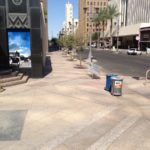A desert downtown lacks shade: the one thing that will make it immensely more walkable year-round.
[editor’s note: This is not the post-Downtown Phoenix Podcast essay promised for Friday. That’s still coming, you guessed it, tomorrow.]

Yesterday, some friends of mine and I went to the afternoon matinee Diamondbacks game at downtown Phoenix’s Chase Field. Despite a D’backs pitching meltdown and more Detroit fans present at the game than Diamondbacks fans, it was a fun afternoon. Leaving Chase Field, though, it became very apparent that we have one major design flaw in our downtown: there’s no shade.
Yep, in a desert city, there’s no shade. And when it’s 115º F (46º C) outside, walking in full sunlight is not a fun thing to be doing. It’s also downright dangerous.
So while we keep thinking of new ways to make downtown Phoenix — and all of our urban environs — if we deny the fundamental fact that we need lots of natural shade, what’s the point? Metal shade doesn’t count. And palm trees, despite being a part of Phoenix’s historic character, provide no environmental benefits to pedestrians.
Some pictures from my collection of an unshaded downtown Phoenix…
This slideshow requires JavaScript.



 If you thought you heard a familiar voice on
If you thought you heard a familiar voice on 



 100 years ago today, a work by Igor Stravinsky received its première performance at the Théâtre des Champs-Élysées. That work was his Le Sacre du Printemps, something that we Anglophones call The Rite of Spring. Needless to say, the performance didn’t go over all that well. The Parisians “hissed” the new work, according to The New York Times‘s reporting.
100 years ago today, a work by Igor Stravinsky received its première performance at the Théâtre des Champs-Élysées. That work was his Le Sacre du Printemps, something that we Anglophones call The Rite of Spring. Needless to say, the performance didn’t go over all that well. The Parisians “hissed” the new work, according to The New York Times‘s reporting.